Long-time readers may remember my post back in 2011, ‘Bringing home the hunny‘. This was the last time we had a significant honey harvest. Back then we found our honey wouldn’t spin out in Emma’s fancy electric centrifugal extractor. By this summer the memory of that had faded, so as we prepared to extract the honey in Emma’s dad’s kitchen we were optimistic that this year would be easier.
First, we decapped the honey with a decapping fork. Once the wax cappings are removed the honey can be spun out in the extractor. Steven Benbow has a nice description of an extractor as “a sort of giant salad spinner for honeycombs” in his book The Urban Beekeeper. Those white buckets we’re using belong to Emma’s dad, who is a butcher and runs his own wholesale company (now semi-retired and only working six days a week).
The darker honey in the foreground comes from my allotment hive in Northfields, west Ealing. The lighter honey on the right comes from Myrtle’s hive a few miles away in Perivale. Emma preferred Myrtle’s honey as she found it more delicate and floral, while I preferred the darker allotment honey as I felt it had more oomph to it.
Decapped allotment honey – dark and rich. Time to extract.
So we put the first three decapped frames in the electric extractor, and left it to spin – and spin, and spin. Every few minutes we checked hopefully to see how much was coming out. But only a trickle gathered at the bottom. Eventually, after about twenty minutes of churning, smoke began coming from the engine. At that point we admitted defeat. Our bees have decided that if we’re going to take their honey, we’re going to have to work for it!
Time for Plan B(ee). We cut the honey away from the foundation and mashed it through colanders. This removed most of the wax, but it will need to be more finely filtered using muslin.
It’s a slow, time-consuming process. Emma is completing it at her flat – thanks Emma!
Sadly, it means we have lost the valuable wax honeycomb cells the bees worked hard to produce. If we could have extracted the honey by spinning it out in the extractor, the comb would have remained intact and would have given our bees a head start next year.
So why is our honey so thick and awkward?
Well, what is honey? Most of us know it’s concentrated nectar, reduced in water content by the bees to around 18% water, at which point they cap the honey cells with wax and it’s ready to be extracted. Once nectar has been evaporated down to 18% water, what’s left is mainly sugar in the form of fructose and glucose. But the proportions of sugar types can vary enormously, so that some honeys will contain more fructose than glucose and vice-versa. On average honey will contain 38-40% fructose, 31-35% glucose, 1-3% sucrose and 17-19% water, along with about 2% minerals, pollen, protein and amino acids (The Honey Bee Around & About by Celia F Davis, Bee Craft Ltd 2009).
The type of sugars contained in honey are one of the factors affecting its viscosity – its thickness. Ted Hooper in his classic Guide to Bees and Honey (2010) explains the varying viscosity of honey:
“Viscosity is the name given to the property of a fluid which causes it to flow slowly, or which resists an object falling through it. … The viscosity of honey is mainly controlled by its gravity, and the lower the water content… the greater will be the viscosity.”
He goes on to say:
“Viscosity is also increased by the amount of colloid material in the honey. The colloids, which are probably small pieces of solid substances and large molecules and include proteins [pollen?], have a similar electric charge and so repel each other. This repulsion again offers a resistance to movement and increases the viscosity, higher in dark than light honey. The extreme example of this is heather honey which has moved beyond a viscous fluid to become a gel.”
He also mentions that honeys with a greater than average proportion of glucose to fructose will granulate more quickly, as glucose is less soluble in water than fructose and crystallises more quickly – oilseed rape honey is an example of this. High viscosity honey also slows down the rate of crystallisation, as molecules of sugar migrate through the honey more slowly. I would say our honey has a high fructose to glucose ratio, as it shows no signs of granulating yet. The 2011 honey we got never did crystallise.
About heather honey, Ted says “Extracting is a problem because the honey is a jelly and will not spin out of combs in the normal way. The jelly is thixotropic, and thus if it is stirred it becomes a fluid and can be extract normally. A form of stirring can be done in the comb using an implement which looks like a scrubbing brush set with fine steel needles for bristles.”
If we had such an implement, perhaps that would have helped – but it sounds very messy! We would love to get our honey tested to find out where the bees have been. Although it’s thick like heather honey, it seems unlikely that the bees have found large quantities of heather in west London. Elder (and younger!) beekeepers, have you ever had such problems extracting?
EDIT: Emma has now written a post on how she’s been getting our stubborn honey out. She’s been hard at work stirring each cell individually with a key… How to extract honey too thick to spin out of a perfectly good extractor.

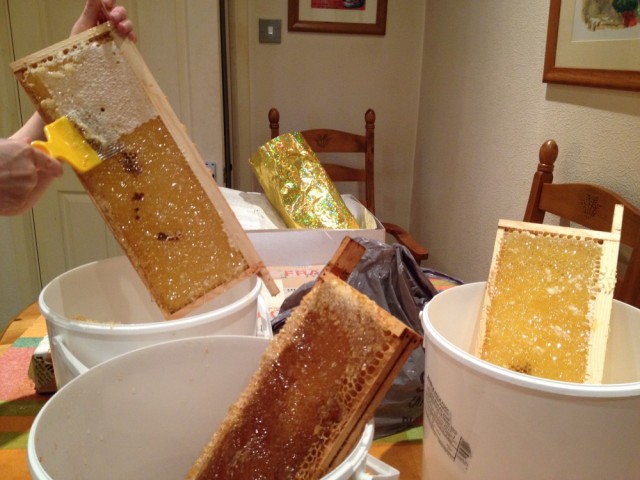

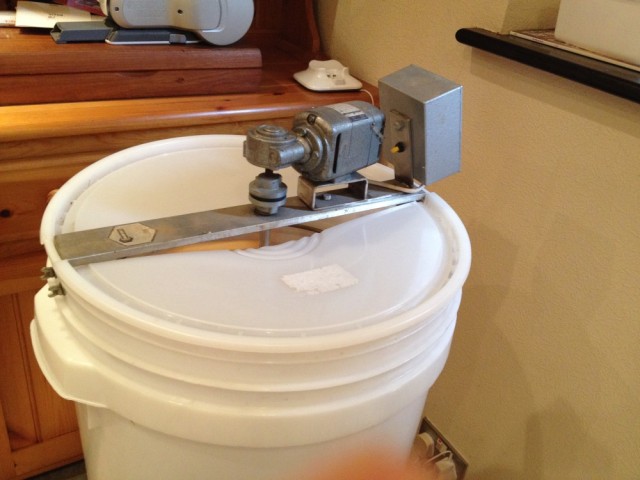
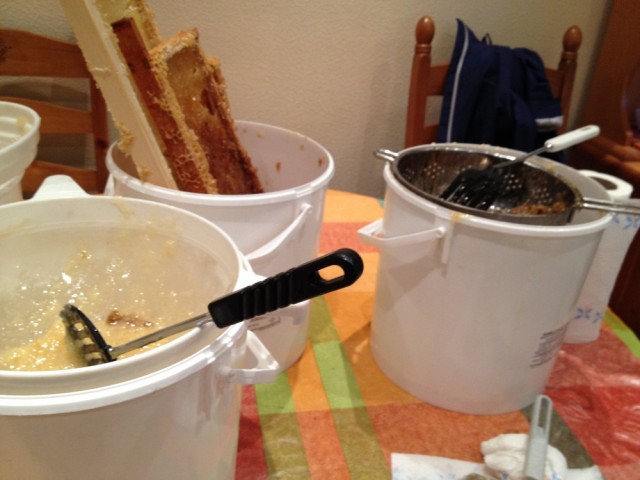
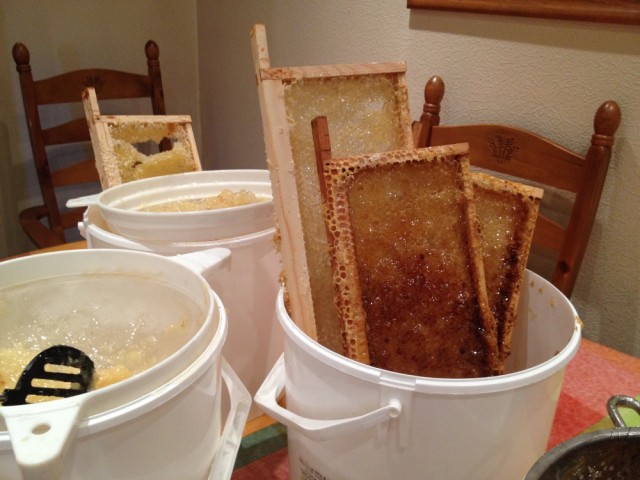
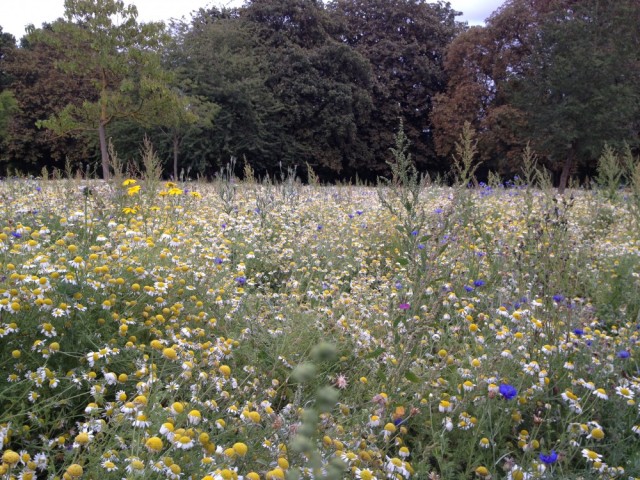
Is like to see more of the inside of the extractor you are using. It sounds a bit odd.
LikeLike
I don’t think it’s particularly unusual – there’s a photo of it from our 2011 extraction here: https://adventuresinbeeland.files.wordpress.com/2011/08/l1020512.jpg
LikeLike
This link gets scary message that the files have been “archived and suspended due to a violation”
We made our eon extractor which works very well I was wondering because if night helped.
LikeLike
That’s weird, I’m not getting that message. It’s the first photo on my 2011 honey extracting post, if you can see that – https://adventuresinbeeland.com/2011/08/08/bringing-home-the-hunny/
LikeLike
It does look like the ones at our bee society. It must be very frustrating that the honey is so thick. Have you tried heating it slightly? I believe that’s a trick with heather honey.
LikeLike
We did try gently warming some frames in the oven, but even that didn’t help!
LikeLike
That’s dreadful. What a messy job!
LikeLike
Emily, I am using an extractor for the first time this year, and found the honey really didn’t start to spin out until we were at pretty high speeds. You start slow and gradually move up as high as you can in terms of speed. I also had to work in a hot garage to keep the honey flowing nicely…as in 95 degrees! Your extractor looks like it simply lacked the necessary power, and since you are processing so few hives, maybe get one of the relatively inexpensive hand crank extractors next year? Your arms will be strong and tireless from a season of beekeeping!
LikeLiked by 1 person
I don’t know what speed our extractor goes up to, but it was spinning around pretty damn fast, much faster than a washing machine or our arms could go. Trouble is the temperature has dropped here now – perhaps next time we could try turning the central heating up really high!
LikeLiked by 1 person
I’ve definitely had the problem you’re talking about. In my case I’ve pinned it down to 2 causes:
1) The honey was very old in the hive before I removed it. I bought old hives that hadn’t been harvested in a couple of years. The comb had been capped then just left for ages by the bees who kept collecting new food and didn’t need to bother with the old stores. That stuff was thick – too thick to spin easily so I did the cut and crush (and wait while it drains and stir up the wax and wait some more).
2) I removed the frames from the hive and stored them for a week before extraction. Again, a lot of crystallised honey.
In my experience, honey that’s been capped the year you’re harvesting it and extracted on the day the frame is removed from the hive is extractable – some thicker and slower, but always most of the honey comes out of the comb so I can return the wet comb to the bees to clean out and get those last precious drops of honey.
That said, we don’t have heather in the area where I live so maybe I’ve just never come across the worst offenders.
LikeLike
Thanks Laura, that’s interesting to know. This honey was collected this summer and wasn’t crystallised, so I don’t think that was the reason in this case.
LikeLike
Oh my. We use a simple hand-crank spinner. Our 8 year old grandson was able to do it. Maybe you should forego the electrical version for good old “elbow grease.”
LikeLike
I don’t think it’s the extractor, as Emma used it to extract honey from her first hive (before we were sharing) back in 2009 without any problems, it flew out really quickly. It spins round like crazy, much faster than any human arm could go. So it must be the honey itself that’s different.
LikeLike
I think you are suffering from gutless extractor motor syndrome from the Far East!
.By the look of them I would have expected those combs to have extracted fairly well,though the colder weather does not help. Here in West Sussex I extracted, from 30 frames today and it was quite thick and heavy going.Mainly Lime but with some early Oilseed Rape clogging things up.
With unwired frames you have to start slowly and then speed up as the flying golden gobbets centrifuge the weight out and reduce the contents and risk of comb collapse.
.For 5 or 6 hives a 9 frame hand crank extractor does the job quite quickly, and you can sense the weight and vary the speed for the unwired frames.
Myrtles honey looks like lovely Lime, your allotment honey is somewhat deliciously darker looking but may be in an older comb,much suburban honey comes from trees.
Incidentally I have found that a stainless hand lever potato ricer bought inexpensively from IKEA flattens wax and extracts beautifully from small pieces of comb if some clear fresh honey is needed for the table.
On a different subject might I suggest that it could be relevant to many contributions if their location could be included somewhere .
LikeLike
Thanks Jonathan. Our extractor only does one speed (super fast), so I wonder if being able to vary it would have helped. Our frames are wired though.
I did think Myrtle’s honey had lime in at the time they were collecting it, as other beekeepers were saying it was out. The allotment honey was made on new foundation from this year so the darkness is all the honey. Thanks for the potato ricer tip!
I have added the location to the post now. Both hives are in Ealing, West London, a few miles apart.
LikeLike
Reblogged this on Linda's wildlife garden and commented:
Awesome and thank you for sharing have a blessed day
LikeLike
Thanks very much Linda, you too 🙂
LikeLiked by 1 person
Sorry to have been rude about it, but the Inside of the extractor looks fine so it may be down to technique. Have you tried taking the grills out(for brood combs size only) and putting more combs in radially like orange segments with the frame lugs slotted into the oblong holes on the outside lower ring? The further out the combs are the more centrifugal force is exerted on the honey, unless it was very cold, at least the lime honey comb you showed would have extracted well. Also the extra weight of more combs would slow the extractor down to start with..Apologies if I am teaching grandmother to suck eggs whilst trying to solve the mystery!
By older comb,I meant earlier in the year,because it looked like a honey arch with the two colours. You have not mentioned dark brown or black Honeydew aphid ‘honey’ which can occur in quantity every so often here in Sussex it tastes good and is sought after on the continent but not UK,.It can be like thick black molasses.
Just do not go into too much detail on its origins at the tea table. Murmur something about beautiful Blackberry flowers or early Blackthorn being prolific this year!! Most beekeepers mix it in and say nothing except ‘the honey is beautifully dark and rich this year’!!
LikeLike
To be honest we hadn’t tried moving the grills and having them radially. But then you say having the combs further out means more centrifugal force is exerted – we had the three combs against the extractor walls – is that what you mean by further out? Extracting honey is still very new to me! When Emma used the extractor the same way a few years ago the honey came out straightaway, which is why we thought the problem must be to do with the honey.
Another beekeeper in the association who has a hand cranked extractor has mentioned he had some problems extracting, despite being a strong man it took him much longer than usual to get the honey out.
Seem to remember I put the super on the allotment bees in late June, so it wasn’t on any earlier in the year than Myrtle’s hive. Perhaps there is a bit of aphid ‘honey’ in there!
LikeLike
I saw a honey extraction on Sunday and they had to lift the frames quickly as the honey was already running out (the room temperature was quite warm.) The extractor was turned by children, first slowly and then increasing in speed. It was mainly sunflower honey – lovely taste and easy to extract. Perhaps you can grow sunflowers on the allotment next year? It seems to depend such a lot on what flowers they visit. Amelia
LikeLike
Sounds dreamy, I’m very jealous! Some people do grow sunflowers on the allotment, but I imagine in France whole fields of sunflowers are grown commercially?
LikeLike
We have acres and acres of them around here.
LikeLike
The final revenge of the bees for stealing their honey 🙂
LikeLiked by 1 person
Yes indeed – they’re not daft!
LikeLike
Hello Emily,
I would definitely unclip the grills for normal super comb extraction and keep them for brood combs containing honey. If you remove them you should be able to get 9 combs in and it should look like bicycle wheel (the spokes being the combs– bottom bars nearest the hub and the lugs of the top bars held in oblong holes on the bottom ring and short metal spurs on the top ring)
The top bars will then be 10cms further out than the screens and therefore subject to more centrifugal force to extract the honey, the light coloured combs would definitely extract like this and if you did several shallow knife cuts down the thixotropic honey combs most of that would come out as well.
You may then need to warm the honey gently before pouring through muslin otherwise it jams up.
I actually use a stainless steel double honey strainer above the muslin because I can then scrape the steel filter when it jams.
I hope some of this makes sense.
LikeLike
Thanks Jonathan, that is useful advice for us to try out next year. It’s been quite hard to find out tips for honey extracting, most of my books make it sound so easy!
LikeLike
Pingback: A Sweet Present | a french garden
I tried to spin once, and our honey is so water-lite (I’m in a desert after all) that it just doesn’t work without warming it up. I’ve done the crush and strain method for four years now and actually prefer it. You pull the honey and wax, drop it in a paint strainer bag set in the top of a 5-gallon bucket, and walk away. But I really like to gather the wax because we do so much with it.
With three hives we’ve worked out a nice balance where we get all the honey we need/want plus the wax, and I don’t spend a Saturday cranking. I suspect this is a to-each-their-own situation.
How much did you get?
LikeLike
Ah yes, I forgot to mention how much we got.. two supers (so about 60 pounds) from Myrtle’s hive, plus I took three frames from the allotment bees. I could have taken more from the allotment bees, but three frames was all I could fit in my bike basket.
Your system sounds good. I’m not especially interested in the wax, but luckily Emma has some plans for it over the winter to make candles/polish.
LikeLike
That’s a happy harvest! We typically get about the same off our first hive and maybe only 10 pounds off the other two.
With our wax, we typically do candles and lotions.
LikeLike
Emily,
One other thought as to your extraction saga,–a theme that does come through many of the above comments is whether the combs had got cold after being taken off the warm hives,in the cold nights we have had recently unless they were kept warm indoors they could have been chilled and difficult to extract.
Many congratulations for your honesty in disaster as well as triumph ,most people only boast about the good bits.and pretend they know everything. With Bees you never will!
As a matter of interest where is ‘Daveloveless in the desert’ from? could it not be in the heading of contributions Sussex Brittany California Maine, the diversity of terrain is so fascinating..
LikeLike
Oh well, there’s no point in only talking about the good bits, the disasters are more interesting! And that way I get advice from knowledgeable people such as yourself.
The combs were kept inside, although not in a particularly warm room. After the initial difficulty spinning we tried gently warming them in the oven, but that still didn’t seem to help. Perhaps we didn’t warm them for long enough.
Dave is from Alaska, although I believe he’s moving soon. It’s fascinating to hear from different beekeepers around the world, some blogs I read talk about how to keep bears and porcupines out!
LikeLike
Remembering my first time extracting honey by hand, it was so messy. I ended up cutting the comb to pieces and ate the whole thing, not all at once. We bought an extractor this year, a manually cranked one but it works great.It has a gear ratio in it so that manually cranking the handle results in much faster spinning inside. Still have to improve on my uncapping ability though. That takes more time than anything else.
LikeLike
Your extractor sounds really good, where did you get it? We used an uncapping fork and I found that fairly quick.
LikeLike
Blimey – never ceases to amaze me, how complicated it all is!
Still – nice to see an end result after such a wait! It’s surprising that the two honeys are so different when so much of the contents are water, glucose and fructose.
LikeLike
Yes, it’s amazing how the different combinations of sugars and the 2% minerals, pollen etc make such a difference. Incidentally honey always tastes best eaten straight from the hive, when there’s a rogue bit of honey comb I love to break it off – the honey is all warm and full of flowery aromas. You always lose something of that aroma when it’s taken away from the hive and bottled.
LikeLike
I must ask what the ambient temperature was? I have tried to extract honey in the high 70’s and it just wasn’t hot enough. The hotter the better for honey flow – like the 90’s!
LikeLike
It wasn’t particularly warm, I must admit. But we did try gently warming some frames in the oven and that didn’t work either.
LikeLike
Emily, I used an uncapping fork this year too…it is nearly as fast as the knife, and almost as fast as a hot air gun (the gun does not open ALL the cells and you end up having to fork them anyway). But with your number of hives I think I would do it all crush and strain, if you don’t mind not having drawn comb at the ready for next year. Have you seen Linda’s Bees video on crush and strain? That is how Iearned and it worked very well.
LikeLike
Thanks for the tip about Linda’s Bees video, will take a look. We did want some drawn comb ready for next spring as it gives the bees such a head start. Ah well.
LikeLike
I enjoyed the explanation on why certain honeys are more viscous than others. Thanks for that, and congratulations on your harvest!
LikeLike
Thanks Julie. I love the sting log on your blog, what a great idea! I haven’t been stung deliberately by our girls this year, but I have been several times by accidentally squashing them with my fingers.
LikeLike